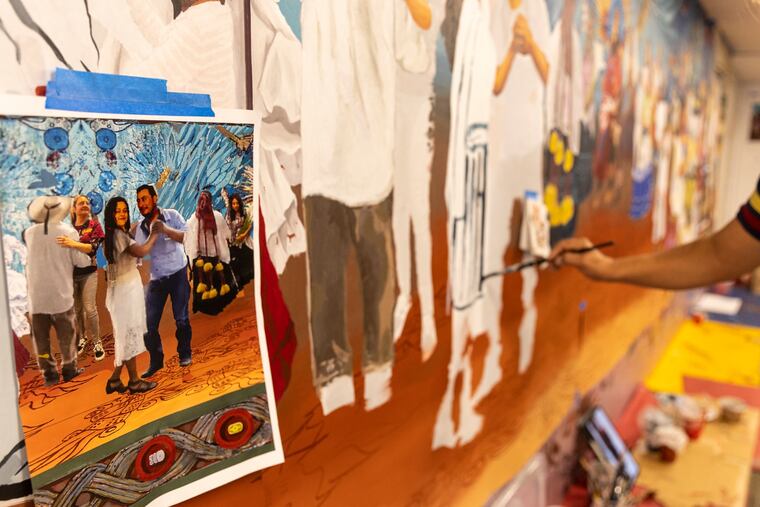These South Philly murals tell Latino immigrants’ stories
“(Immigrants) are able to share their stories. We’re there to hear them,” said Lemus, a first-generation Mexican American and the arts and education coordinator at Puentes de Salud.

Stories cover the walls of Puentes de Salud.
The deep blues of the skies contrast with the clay reds of the ground. Men and women grow and harvest corn. Rolling pins flatten tortilla dough as a roaring fire next door cooks them to perfection. An older woman dons a traditional Salvadoran white-and-royal blue dress, adorned with intricate embroidery. Cochineal insects get crushed into a brilliant red dye for clothing. A kiln glazes pottery pieces.
A man rolls up his petate, straps it onto his back, and begins his immigration journey.
These scenes are just snippets of the vivid, immersive murals covering the walls of the health clinic for Latino immigrants based in South Philly. Funded in part by the William Penn Foundation and KABOOM, as part of a project on literacy called the Informal Learning Initiative, the collaborators behind the murals had one goal: to tell the community’s stories.
“[Immigrants] are able to share their stories. We’re there to hear them,” said Lemus, who asked to be referred to by his last name, a first-generation Mexican American and the arts and education coordinator at Puentes. “And when you tell a story, you’re valued. So this is a project that provided that sense of value.”
The snapshots depicted in the murals showcase Latino history, from the Aztec and Mayan empires to Spanish colonialism to present day, as well as Latino culture and traditions. The artists designing the mural portrayed the simultaneous diversity yet similarity of cultures across Latin America, but they particularly wanted to highlight the richness and impressive skills passed down through generations: discovering how to make red dye (which colonizers later took back to Europe), labor-intensive dishes, horticulture, agriculture, pottery, embroidery, and more.
“By displaying what we are in community, you pull out what is great about you — your best dress, your best food — to showcase.”
“By displaying what we are in community, you pull out what is great about you — your best dress, your best food — to showcase,” Ivonne Pinto-García, a community leader and artist from Puebla, Mexico, said in Spanish through an interpreter.
“It is very, very important that the community receive recognition, and that they can continue to pass this along to their children, their nephews and nieces,” she continued. “You bring your past with you, and you start transforming, and [it is important to have] places like this that say, ‘You are free to show us what you bring with you.’ [This mural] is not saying, ‘This is what my ancestors did and it has been forgotten,’ but rescuing — even if we have to tear and scratch to reclaim it — who and what we have been.”
By showcasing the richness and beauty of Latino cultures, the collaborative team working on the murals is aiming to foster a sense of pride and empowerment among every Latino who sets eyes on the artwork. This is particularly important in the face of xenophobia and racism, which sometimes discourages immigrants from holding on to and passing down their heritages.
“Kids know that they come from Honduras or El Salvador, but because of immigration, that’s not so hot of a topic, and it’s almost like a lesser type of culture where they’re coming from because they’re here,” said Nora Litz, director of arts and culture at Puentes, who is originally from Mexico City.
“That’s not true. So the pride that comes with it, that it’s not like my parents hardly know how to read and write, but look at the other things they can do.”
In pursuing this project, the collaborative was intentional about flipping the script to showcase the community’s assets and abilities, rather than the barriers they face.
“How can we build from those bases of strength to think holistically about what it means to be a literate person in the world?” asked Leah Reisman, director of health and wellness at Puentes. “Not only how to read and write, but how to be literate in your identity, how to read the world around you, how to operate in the many languages and cultural traditions that we see here in Philadelphia.”
» READ MORE: Immigrants have long been vital to the arts scene in Philadelphia | Opinion
The murals were designed in collaboration with community members, and many of their faces have actually been painted onto the different images — underscoring Puentes’ habit of respecting, empowering, and working with (not serving, Litz said) community members. The interactive murals are intended to be evocative and prompt families to have intergenerational conversations about their roots and stories.
For Teddy Hannah-Drullard, an Afrolatinx portrait artist collaborating on the murals, this project served as a way for them to connect with their Dominican roots that they’ve been deprived of due to familial circumstances.
“That’s kind of a disruption that I think a lot of people can feel, especially coming to the country and then being first- or second-generation American,” they said. “Getting invited to work on this project, and learning a little bit about Latino culture in general, I’m like, ‘Here’s this thing that I didn’t know I was missing this whole time, that I didn’t know I needed to feel fulfilled.’”